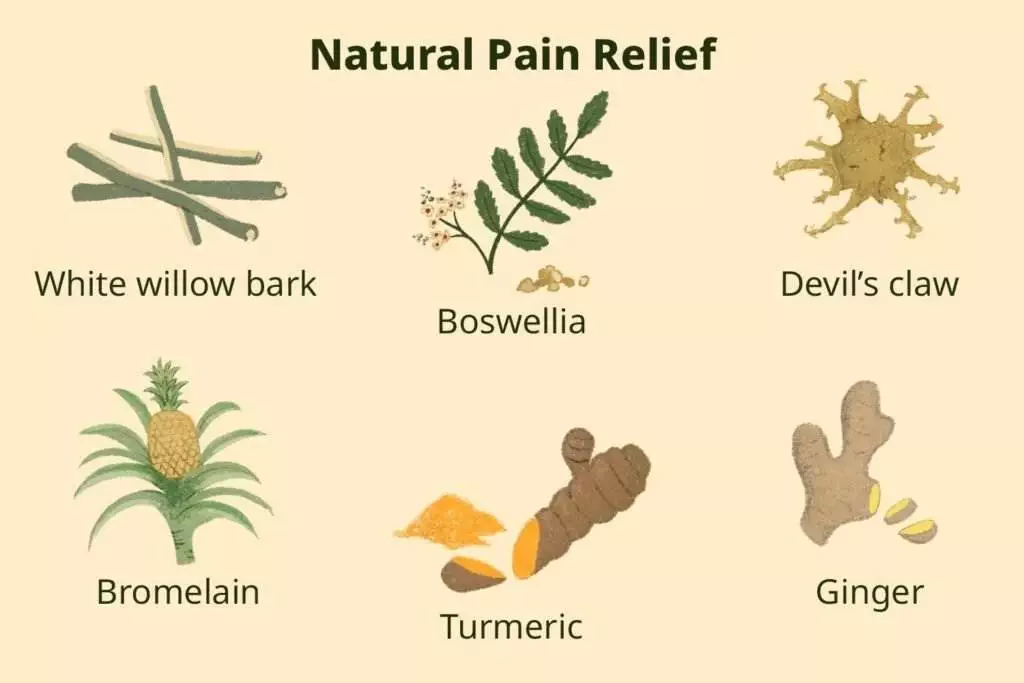
If you’re seeking alternative ways to manage pain without relying solely on medications, then “The Introduction to Natural Pain Remedies” is the perfect starting point. This article aims to provide a comprehensive overview of natural pain remedies, highlighting their evidence-based benefits. By exploring the world beyond traditional methods, you’ll discover various natural options to help alleviate discomfort and enhance your overall well-being. From herbal remedies to mindfulness practices, this introduction will set you on the path toward finding practical and sustainable solutions for managing pain naturally.

Understanding Pain
Pain is a universal experience that comes in various forms and intensities. It can range from a mild inconvenience to a debilitating condition that affects every aspect of your life. Understanding the different types of pain, their causes, and their effects is crucial in finding the most effective pain relief methods.
Types of Pain
Pain can be categorized into two main types: acute and chronic. Acute pain is short-term and typically occurs due to injury or illness. It is a warning sign to alert you of potential harm and usually subsides as the underlying cause heals. On the other hand, chronic pain lasts for an extended period, often for at least three months or more. Various conditions, such as arthritis, nerve damage, or ongoing illnesses, can cause it.
Causes of Pain
Pain can stem from a wide range of causes. It can result from an injury, such as a sprained ankle or a broken bone. Infections, inflammation, and medical conditions like fibromyalgia or migraines can also trigger pain. Lifestyle factors like poor posture, stress, and lack of exercise can also contribute to chronic pain.
Effects of Pain
Living with pain can profoundly impact your physical, emotional, and mental well-being. It can limit your mobility, affect your sleep, and hinder your ability to perform daily activities. Chronic pain can lead to feelings of depression, anxiety, and frustration, as it can become a constant source of discomfort and distress. Finding effective pain relief methods is essential for restoring your quality of life.
Conventional Pain Relief Methods
Conventional medicine offers a variety of pain relief methods, both over-the-counter and prescription-based. These methods often provide immediate relief but may come with limitations and potential side effects.
Over-the-Counter Medications
Over-the-counter (OTC) pain relievers, such as acetaminophen and nonsteroidal anti-inflammatory drugs (NSAIDs), can effectively manage mild to moderate pain. They work by reducing inflammation and blocking pain signals to the brain. However, following the recommended dosage and avoiding long-term or excessive use is essential, as it can lead to complications like liver damage or gastrointestinal issues.
Prescription Drugs
For severe pain, prescription medications like opioids may be prescribed. Opioids bind to specific receptors in the brain and spinal cord, minimizing pain perception. While they can be highly effective in providing relief, they come with the risk of dependence and addiction, making them less suitable for long-term use. It is essential to use prescription drugs under the supervision of a healthcare professional and follow the recommended guidelines.
Physical Therapy
Physical therapy is a conventional approach to pain management that aims to improve mobility, reduce pain, and enhance overall function. It involves targeted exercises, stretches, and techniques to strengthen muscles, improve flexibility, and promote healing. Physical therapy can benefit various conditions, such as musculoskeletal injuries, chronic pain, and post-surgical rehabilitation. It is often used with other treatment modalities for comprehensive pain relief.
The Limitations of Conventional Medicine
While conventional pain relief methods have their place in managing pain, they also have limitations and potential drawbacks.
Side Effects
Many conventional pain medications, especially prescription opioids, can cause various side effects. These may include drowsiness, constipation, nausea, and even respiratory depression. Long-term use of certain medications can also lead to organ damage, such as kidney or liver impairment. It is important to discuss potential side effects with your healthcare provider and weigh the risks and benefits before starting any medication.
Dependency
Due to the potential for dependence and addiction, some pain medications can create a cycle of reliance that is difficult to break. This can lead to escalating dosages or the need for stronger medications as the body builds tolerance. Breaking free from this cycle can be challenging and requires professional support and guidance.
Ineffectiveness for Chronic Pain
Conventional medicine may not always provide optimal relief for chronic pain conditions. Chronic pain is often multifaceted, involving complex mechanisms that may not respond well to traditional approaches. In such cases, alternative and complementary methods might be worth exploring for better pain management and improved quality of life.
Exploring Natural Pain Remedies
Natural pain remedies offer alternative approaches to pain management that focus on holistic healing and promote overall well-being. These methods aim to address the underlying causes of pain rather than simply masking the symptoms. While natural remedies may not be suitable for all types of pain, they can complement conventional treatments and provide additional options for those seeking alternative approaches.
Herbal Remedies
Herbal remedies have been used for centuries to alleviate pain and promote healing. Some common herbal remedies for pain relief include turmeric, willow bark, and Ginger. Turmeric contains curcumin, which has anti-inflammatory properties that can help reduce pain and swelling. Willow bark contains a natural form of salicylic acid, similar to the active ingredient in aspirin, making it an effective analgesic. Ginger, known for its anti-nausea properties, has also been found to have pain-relieving effects.
Acupuncture
Acupuncture is an ancient Chinese practice that involves inserting thin needles into specific points on the body. It is based on the concept of energy flow, known as Qi, and aims to restore balance and promote healing. Acupuncture has been shown to stimulate the release of endorphins, the body’s natural painkillers, and improve blood flow to affected areas. It can effectively manage various types of pain, including musculoskeletal conditions, migraines, and neuropathic pain.
Meditation and Mindfulness
Meditation and mindfulness techniques can be powerful tools for pain management. By focusing your attention and achieving a state of deep relaxation, you can reduce stress and alter your perception of pain. Mindfulness practices involve being fully present in the moment and observing your thoughts and sensations without judgment. These practices can help shift the focus away from pain and promote a sense of calm and well-being.

Herbal Remedies for Pain Relief
Herbal remedies have long been used to provide natural relief for various types of pain. Here are some herbal remedies that have shown promise in alleviating pain.
Turmeric
Turmeric, a spice commonly used in Indian cuisine, contains a compound called curcumin, which has potent anti-inflammatory properties. Inflammation is often a significant contributor to pain, especially in conditions like arthritis. Turmeric can help reduce inflammation and relieve joint pain, muscle aches, and headaches. It can be consumed as a supplement or added to food dishes for a natural boost in pain relief.
Willow Bark
Willow bark has been used for centuries as a natural remedy for pain. It contains salicin, a compound converted to salicylic acid in the body, similar to the active ingredient in aspirin. Willow bark has analgesic and anti-inflammatory properties, effectively reducing pain and inflammation. It can be consumed as a tea or taken in supplement form. Still, it’s essential to consult with a healthcare professional before using willow bark, especially if you have any underlying medical conditions or are taking other medications.
Ginger
Ginger is a root known for its many health benefits, including its ability to reduce pain. It contains gingerols, compounds that have potent anti-inflammatory and analgesic properties. Ginger can help alleviate muscle pain, joint pain, and menstrual cramps. It can be consumed in various forms, such as fresh or dried Ginger, ginger tea, or ginger supplements. Adding Ginger to your diet or incorporating it into your recipes can be a flavorful way to harness its pain-relieving properties.
The Power of Acupuncture
Acupuncture is a traditional Chinese medical practice that has gained recognition worldwide for providing pain relief and promoting overall well-being. Understanding how acupuncture works and its potential benefits can help you make an informed decision when considering this alternative pain management option.
How Acupuncture Works
Acupuncture is based on the concept of energy flow, known as Qi, through pathways called meridians in the body. According to traditional Chinese medicine, when Qi becomes imbalanced or blocked, it can lead to pain and illness. Acupuncture involves the insertion of thin needles into specific points along the meridians to stimulate and restore the flow of Qi. This, in turn, can promote healing, alleviate pain, and restore balance to the body.
Benefits of Acupuncture
Acupuncture has been shown to provide pain relief for various conditions, including musculoskeletal pain, migraines, and neuropathic pain. It stimulates the release of endorphins, the body’s natural painkillers, which can help reduce pain and promote well-being. Acupuncture can also improve blood circulation, enhance immune function, and reduce inflammation. It is a safe and drug-free approach to pain management that can be used alone or in conjunction with other treatment modalities.
Safety and Risks
When performed by a trained and licensed acupuncturist, acupuncture is considered a safe and well-tolerated treatment option. The needles used are sterile, single-use, and typically cause minimal discomfort. However, there is a risk of infection if proper sanitation practices are not followed. It’s important to seek acupuncture from a reputable practitioner who adheres to strict hygiene protocols. Additionally, if you have a bleeding disorder or are taking blood-thinning medications, you must inform your acupuncturist to avoid complications.

Meditation and Mindfulness for Pain Management
Meditation and mindfulness techniques offer a holistic approach to pain management by addressing the mind-body connection. These practices can help shift your perception of pain, reduce stress, and promote relaxation, improving overall well-being.
Mind-Body Connection
The mind-body connection refers to our thoughts, emotions, and beliefs that influence physical well-being. When it comes to pain, negative thoughts, stress, and anxiety can intensify the perception of pain and make it more difficult to cope. Meditation and mindfulness practices can help break this cycle by bringing awareness to the mind-body connection and promoting a sense of calm and relaxation.
Pain Perception and Stress
Stress and pain have a reciprocal relationship, often exacerbating pain and pain-causing stress. Chronic stress can trigger the release of stress hormones, such as cortisol, which can increase pain sensitivity. By managing stress through meditation and mindfulness, you can lower your overall stress levels, reducing pain perception and improving pain management.
Techniques for Pain Relief
Meditation and mindfulness techniques offer a variety of approaches for pain relief. These can include focused breathing exercises, body scan meditations, and visualization techniques. Focused breathing involves concentrating your attention on your breath as an anchor to still the mind and redirect your focus away from pain. Body scan meditations involve systematically scanning the body with awareness and observing any sensations or areas of discomfort without judgment. Visualization techniques involve mentally picturing a peaceful, pain-free environment or visualizing the pain dissipating. By incorporating these practices into your daily routine, you can cultivate a greater sense of inner peace and reduce your experience of pain.
Alternative Therapies for Pain Relief
In addition to herbal remedies, acupuncture, and meditation, several alternative therapies can relieve pain. These complementary approaches aim to address pain from different perspectives and provide additional options for pain management.
Chiropractic Care
Chiropractic care focuses on the relationship between the spine and the nervous system and how it impacts overall health. Chiropractors use manual adjustments and spinal manipulations to correct misalignments in the spine, known as subluxations. By realigning the spine, chiropractors aim to restore proper nervous system function and alleviate pain. Chiropractic care is commonly used to manage conditions like back pain, neck pain, and headaches.
Massage Therapy
Massage therapy involves the manipulation of soft tissues, such as muscles, tendons, and ligaments, to promote relaxation and alleviate pain. Different techniques, such as Swedish massage, deep tissue massage, and trigger point therapy, can target specific areas of pain and tension. Massage therapy can help reduce muscle stiffness, improve circulation, and release endorphins, ultimately providing pain relief and promoting overall well-being.
Aromatherapy
Aromatherapy involves using essential plant oils to promote physical and psychological well-being. Certain essential oils, such as lavender, peppermint, and eucalyptus, have analgesic and anti-inflammatory properties that can provide natural pain relief. They can be inhaled, applied topically, or used in a diffuser to create a soothing environment. Aromatherapy can complement other pain management techniques and enhance their effectiveness.

Non-Pharmacological Pain Relief Methods
Non-pharmacological pain relief methods offer drug-free alternatives for managing pain. These approaches focus on the body’s ability to heal and promote overall well-being. Incorporating these methods into your pain management strategy can provide additional options and help reduce reliance on medication.
Heat and Ice Therapy
Heat and ice therapy are simple yet effective methods for pain relief. Heat therapy, such as heating pads or warm baths, can help relax muscles, increase blood flow, and alleviate pain. On the other hand, ice therapy can reduce inflammation, numb the area, and provide temporary relief. Applying ice packs or ice massage to the affected area can help reduce pain and swelling. Using these therapies appropriately and avoiding prolonged exposure to extreme temperatures is essential to prevent burns or skin damage.
Transcutaneous Electrical Nerve Stimulation (TENS)
Transcutaneous Electrical Nerve Stimulation (TENS) is a non-invasive technique that uses low-voltage electrical currents to relieve pain. TENS units are portable devices that can be applied to the skin near the site of pain. The electrical currents stimulate nerve fibers, which can help reduce pain signals and promote the production of endorphins. TENS can be particularly effective for managing chronic pain conditions like arthritis or neuropathic pain.
Exercise and Physical Activity
Regular physical activity and exercise can play a significant role in pain management. Exercise helps strengthen muscles, improve flexibility, and increase circulation, all of which can reduce pain and enhance overall well-being. Low-impact activities like walking, swimming, or yoga can particularly benefit those with chronic pain. It’s important to start slowly and choose exercises appropriate for your fitness level and individual needs. Consulting with a healthcare professional or a physical therapist can guide the most suitable activities for your condition.
Combining Natural and Conventional Approaches
While natural pain remedies and conventional medicine offer different approaches to pain relief, combining these methods can often provide the most comprehensive and effective results. Taking a complementary or integrated approach to pain management can maximize the benefits of each modality and improve your overall well-being.
Complementary Approach
A complementary approach involves using natural pain remedies alongside conventional treatments to enhance pain relief. This can include incorporating herbal remedies, acupuncture, or mindfulness techniques into your pain management plan while still following the advice and guidance of your healthcare provider. By addressing both the symptoms and underlying causes of pain, a complementary approach can provide a more holistic and personalized plan for pain relief.
Integrated Approach
An integrated approach to pain management involves the collaboration between natural pain remedies and conventional medicine. This approach recognizes that each individual’s pain experience is unique and may require a combination of therapies to achieve optimal results. By working closely with your healthcare team, including physicians, alternative practitioners, and therapists, an integrated approach can provide a comprehensive and tailored plan that considers your needs and preferences.
Collaborative Healthcare
Collaborative healthcare involves open communication and cooperation between healthcare providers from different disciplines. This approach recognizes the value of multiple perspectives and expertise in managing pain. Collaborative healthcare teams may include physicians, physical therapists, acupuncturists, chiropractors, and other professionals working together to provide a comprehensive and well-rounded plan for pain relief. By utilizing the knowledge and skills of each team member, collaborative healthcare can offer a more comprehensive and personalized approach to pain management.
In conclusion, understanding the nuances of pain, the limitations of conventional medicine, and the potential benefits of natural pain remedies allows you to make informed decisions regarding your pain management. Whether you explore herbal remedies, acupuncture, meditation, or a combination of these methods, finding the right approach is essential. By taking a holistic and comprehensive approach to pain relief, you can enhance your overall well-being and regain control of your life. Remember to consult with your healthcare provider before starting any new pain relief methods to ensure they suit your needs.

